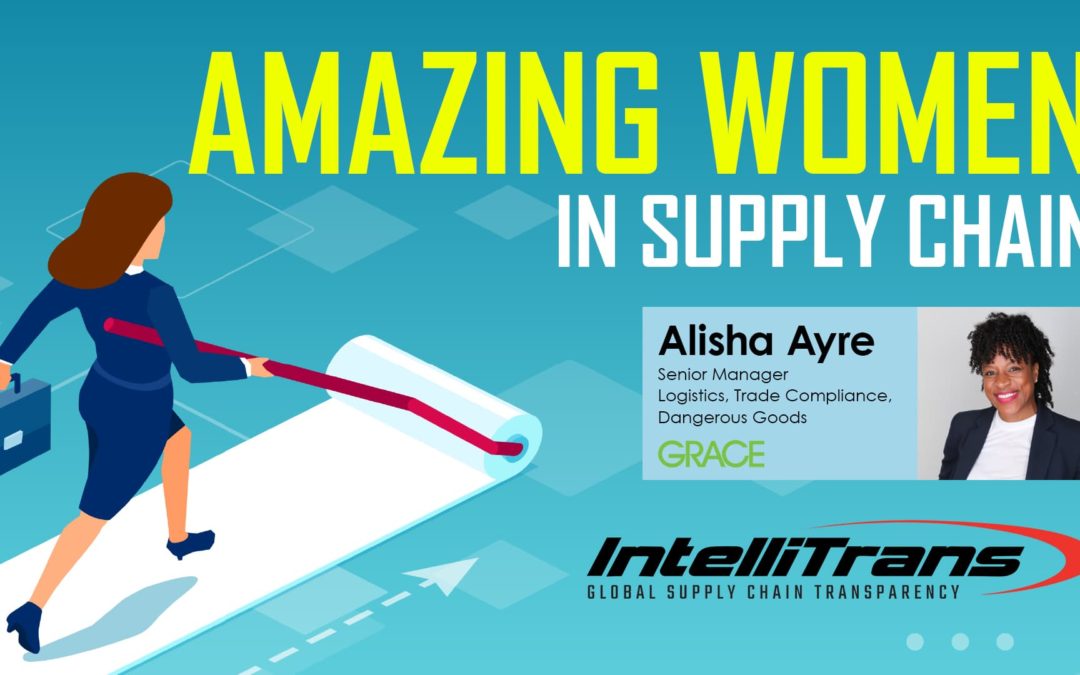By blending engineering and business experience, Alisha Ayre found the perfect balance of skillsets and knowledge needed for a successful, long-term career in supply chain and logistics.

She’s Helping to Drive the Future of Supply Chain
Alisha Ayre was working on an engineering assignment in Ireland when she realized that her true calling was probably a career in supply chain and logistics. Working for Johnson & Johnson at the time, she was handling the engineering for a new plant that was ultimately going to manufacture a semi-finished product (versus one to be sold directly to consumers or to a pharmaceutical firm).
“A lightbulb came on when I realized that we’d have to figure out how to make the material that was going to be feeding another process downstream in the supply chain,” says Ayre. “At that point, it was ‘all systems go’ and nothing but supply chain responsibilities from that day forward.”
As it turns out, Ayre was extremely well suited for a leadership position in supply chain, where she could effectively blend her analytical capabilities and business sense without being totally committed to one or the other. In 2008, she took on a supply chain leadership role with consulting firm Booz Allen Hamilton. Three years later, she was hired by W.R. Grace as a Lead Six Sigma Black Belt supporting the company’s supply chain and logistics operations.
“I was able to leverage many of the skillsets that I’d acquired while working for Johnson & Johnson, and the depth of knowledge that I acquired working in consulting for a few years,” says Ayre, CSCMP, Senior Manager, Logistics, Warehousing & Trade Compliance.
“With my blend of technical background plus an understanding of the business,” she continues, “I can pull the various pieces together and really anticipate the company’s needs and help it overcome challenges and seize opportunities.”
A Broad Range of Responsibilities
Founded in 1854, W.R. Grace is a Columbia, Md.-based producer of specialty chemicals and specialty materials. The company’s two divisions—Grace Catalysts Technologies and Grace Materials and Chemicals—have operations in 30 countries and customers in 60 countries. Managing a 4-person team, Ayre is responsible for all inbound and outbound North American freight movement.
“There are a lot of transactions being managed by just four people,” says Ayre. Shipping primarily by rail, the team also handles dangerous goods and trade compliance. “Rail tends to be very nuanced and not everyone understands it, so we have one position dedicated just to rail,” Ayre explains. “That’s how we made the connection with IntelliTrans.”
With IntelliTrans’ supply chain visibility platform and transportation management system (TMS), in its corner, W.R. Grace’s logistics team can effectively manage those nuances. It also works with several third-party providers that handle some of the organization’s day-to-day logistics activities, including a 4PL that negotiates freight procurement contracts for its established, North American lanes (among other responsibilities).
Another third-party provider handles all of W.R. Grace’s freight forwarding and import customs brokerage. All of the providers feed data onto a single platform that Ayre uses to review performance and make sound decisions. “We have one control tower for all trucks, leases, rail cars, and demurrage. It all flows through one funnel,” says Ayre. “That control tower allows me to easily run reports, track metrics, and access data in one silo.”
Leveraging Technology
Ayre views her current role as being one part provider relationship manager and one part supplier relationship manager. As a whole, the logistics team works hard to ensure that W.R. Grace’s providers truly understand why they’re being asked to do things, versus just telling them what to do.
A year like no other, at least from the tactical standpoint, 2020 put unique pressures on W.R. Grace’s logistics team, which is now viewing the world more strategically and coming up with new ways to track and anticipate the pace and movement of its freight. The team relies on technology partners like IntelliTrans to help it streamline its logistics operations and gain efficiencies. Because it works across most modes, the company seeks out partners and technology that can help it connect the dots across those various modes.
“Our main challenge is finding someone that can do it all, and who incorporates all of the complexity that comes along with W.R. Grace and the customized decisions that were made back in the early-2000s and late-1990s, when SAP was implemented,” says Ayre, “and that allows us to leverage new technology without having to reinvent the wheel.”
Making Big Strides
With nearly two decades of supply chain and logistics experience under her belt, Ayre says she’s been “fairly blessed” in that the companies she’s worked for have possessed a good amount of gender diversity. That level of diversity has increased over time, with more women now taking an interest in internships and careers in the field. Others are taking on leadership and project management roles—something that Ayre is happy to see more of. “To me, that speaks volumes about how, in general and from a corporate perspective, strides have been made,” says Ayre. “Unfortunately, I still think we’ve got a good way to go.”
To women either just making their way into supply chain or looking to advance their careers, Ayre says her advice is simple: be yourself. “I tried early on in my career to fit into that male stereotype by dressing and acting a certain way,” she explains, “but I quickly learned that there’s a fine line between remaining polished and understanding the cultural nuances of a certain organization, and completely losing yourself and your corporate identity.”
As the world of supply chain continues to evolve, Ayre expects topics like diversity, sustainability, and other issues that were an afterthought just 15 years ago to become increasingly important. “The company that can strike the right balance for their business model between third-party providers, technology, sustainability, and diversity,” she predicts, “will be the ones that are driving the future of supply chain.”

